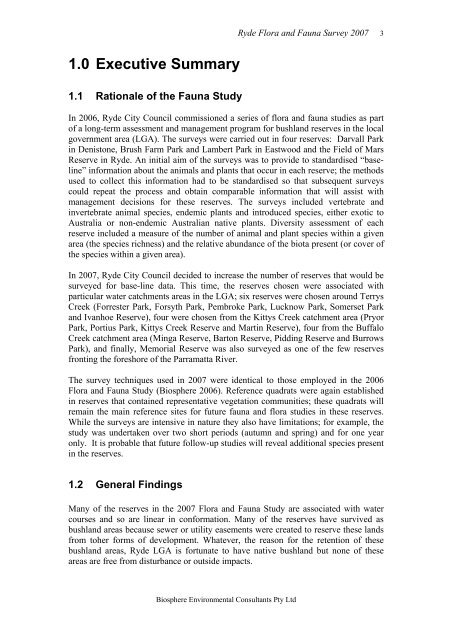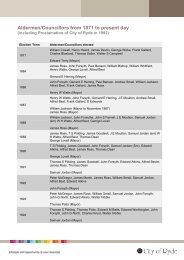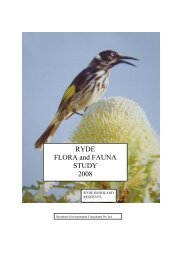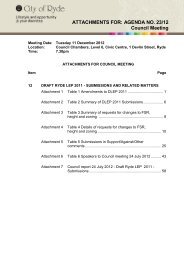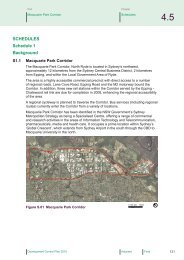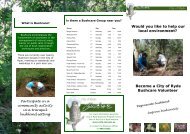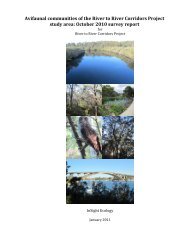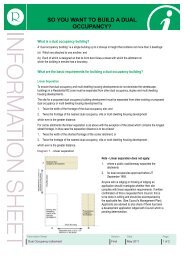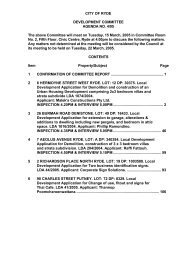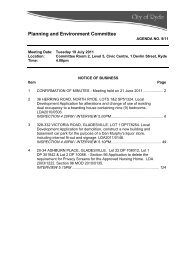RYDE FLORA and FAUNA STUDY 2007 - City of Ryde - NSW ...
RYDE FLORA and FAUNA STUDY 2007 - City of Ryde - NSW ...
RYDE FLORA and FAUNA STUDY 2007 - City of Ryde - NSW ...
You also want an ePaper? Increase the reach of your titles
YUMPU automatically turns print PDFs into web optimized ePapers that Google loves.
1.0 Executive Summary<br />
1.1 Rationale <strong>of</strong> the Fauna Study<br />
Biosphere Environmental Consultants Pty Ltd<br />
<strong>Ryde</strong> Flora <strong>and</strong> Fauna Survey <strong>2007</strong> 3<br />
In 2006, <strong>Ryde</strong> <strong>City</strong> Council commissioned a series <strong>of</strong> flora <strong>and</strong> fauna studies as part<br />
<strong>of</strong> a long-term assessment <strong>and</strong> management program for bushl<strong>and</strong> reserves in the local<br />
government area (LGA). The surveys were carried out in four reserves: Darvall Park<br />
in Denistone, Brush Farm Park <strong>and</strong> Lambert Park in Eastwood <strong>and</strong> the Field <strong>of</strong> Mars<br />
Reserve in <strong>Ryde</strong>. An initial aim <strong>of</strong> the surveys was to provide to st<strong>and</strong>ardised “baseline”<br />
information about the animals <strong>and</strong> plants that occur in each reserve; the methods<br />
used to collect this information had to be st<strong>and</strong>ardised so that subsequent surveys<br />
could repeat the process <strong>and</strong> obtain comparable information that will assist with<br />
management decisions for these reserves. The surveys included vertebrate <strong>and</strong><br />
invertebrate animal species, endemic plants <strong>and</strong> introduced species, either exotic to<br />
Australia or non-endemic Australian native plants. Diversity assessment <strong>of</strong> each<br />
reserve included a measure <strong>of</strong> the number <strong>of</strong> animal <strong>and</strong> plant species within a given<br />
area (the species richness) <strong>and</strong> the relative abundance <strong>of</strong> the biota present (or cover <strong>of</strong><br />
the species within a given area).<br />
In <strong>2007</strong>, <strong>Ryde</strong> <strong>City</strong> Council decided to increase the number <strong>of</strong> reserves that would be<br />
surveyed for base-line data. This time, the reserves chosen were associated with<br />
particular water catchments areas in the LGA; six reserves were chosen around Terrys<br />
Creek (Forrester Park, Forsyth Park, Pembroke Park, Lucknow Park, Somerset Park<br />
<strong>and</strong> Ivanhoe Reserve), four were chosen from the Kittys Creek catchment area (Pryor<br />
Park, Portius Park, Kittys Creek Reserve <strong>and</strong> Martin Reserve), four from the Buffalo<br />
Creek catchment area (Minga Reserve, Barton Reserve, Pidding Reserve <strong>and</strong> Burrows<br />
Park), <strong>and</strong> finally, Memorial Reserve was also surveyed as one <strong>of</strong> the few reserves<br />
fronting the foreshore <strong>of</strong> the Parramatta River.<br />
The survey techniques used in <strong>2007</strong> were identical to those employed in the 2006<br />
Flora <strong>and</strong> Fauna Study (Biosphere 2006). Reference quadrats were again established<br />
in reserves that contained representative vegetation communities; these quadrats will<br />
remain the main reference sites for future fauna <strong>and</strong> flora studies in these reserves.<br />
While the surveys are intensive in nature they also have limitations; for example, the<br />
study was undertaken over two short periods (autumn <strong>and</strong> spring) <strong>and</strong> for one year<br />
only. It is probable that future follow-up studies will reveal additional species present<br />
in the reserves.<br />
1.2 General Findings<br />
Many <strong>of</strong> the reserves in the <strong>2007</strong> Flora <strong>and</strong> Fauna Study are associated with water<br />
courses <strong>and</strong> so are linear in conformation. Many <strong>of</strong> the reserves have survived as<br />
bushl<strong>and</strong> areas because sewer or utility easements were created to reserve these l<strong>and</strong>s<br />
from toher forms <strong>of</strong> development. Whatever, the reason for the retention <strong>of</strong> these<br />
bushl<strong>and</strong> areas, <strong>Ryde</strong> LGA is fortunate to have native bushl<strong>and</strong> but none <strong>of</strong> these<br />
areas are free from disturbance or outside impacts.


